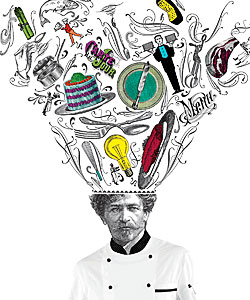
I was bellied up to the Lula Cafe bar one fall evening when chef Jason Hammel presented me a salad of spaghetti squash poached in hazelnut oil, crispy trout skin, smoked trout roe, hazelnuts, celery aïoli, and ruby streaks mustard greens. I took a bite. Shock and awe. Visible swooning.
But what stunned me most was that the dish was unlike anything I’d tasted before. For a professional chef who has devoted her life to eating and cooking—currently at Sunday Dinner Club, a periodic underground event—that’s kind of a big deal. As my brain uploaded the startling new flavor and texture data, my pressing question for Hammel wasn’t, “How did you make this?” It was, “How the heck did you come up with this?”
I constantly refer back to the words on page 5 of Austin Kleon’s Steal Like an Artist: “Every artist gets asked the question, ‘Where do you get your ideas from?’ The honest artist answers, ‘I steal them.’ ”
This is not to imply that Hammel ripped off that amazing dish. It came to him by way of an aïoli recipe in Mission Street Food’s cookbook that motivated him to use more nut oils. Hmm, he thought—as only a chef can. Maybe I’ll try poaching squash in hazelnut oil. The rest followed naturally. That’s not theft, it’s inspiration, and it’s how chefs, professional and amateur alike, function. (Haven’t you ever “adjusted” a friend’s recipe?)
My fellow chef at Sunday Dinner Club, Josh Kulp, and I get inspiration from everywhere: cookbooks, dining out, traveling, reading menus. We take solace in the knowledge that when we borrow from another chef, that chef has borrowed too. Because no one creates in a vacuum, and anyone who claims otherwise is surely lying.
The trouble, of course, comes when the process happens more directly. The most notorious case is Robin Wickens, the Australian chef who interned at Alinea for a week in 2005 and then carbon-copied the hell out of Grant Achatz’s menu back at his Melbourne restaurant. Blatantly plagiarizing another chef isn’t cool, man—but building on ideas borrowed from another chef is acceptable, even flattering, as long as the builder acknowledges the source. (Hey, Stephanie Izard: Thanks again for the candied eggplant with doughnuts idea!)
The end result is honest and new because our influences graft onto the story of our food. “There’s original voice,” says Amanda Hesser, cofounder of the online culinary community Food52. “There aren’t original recipes.”
Most chefs will tell you we are at a point where a lot of things have been done before. But it’s a cop-out to say there are no original ideas. “If you start with the assumption that nothing is new,” says Jason Vincent, the chef of Nightwood in Pilsen, “then the conversation is over.”
Vincent had been working on a dish that included an egg poached in plastic wrap, a method he learned while cooking at Arzak in San Sebastian, Spain. He didn’t want to lift it directly, so he played around with the format and made it his own. Daniel Patterson, the highly regarded chef of Coi in San Francisco, cares less about influence than about the end product. “Are people expressing themselves in a way that’s theirs?” he asks. “That’s honesty.”
So let’s be honest here. When chefs use recipes as springboards for their own creativity, that’s honest. Exchanging ideas with other chefs? Totally honest. Working in a restaurant, taking pictures, and then claiming the food as your own? It’s like giving the finger to everyone in that kitchen. A true mensch gives a high-five to those who spark his creativity. Because lists of ingredients are not protected by copyright, the only judge and jury who draw lines between homage, inspiration, and outright theft are the chefs.
In the end, it doesn’t matter where the ideas come from—only that they continue to come. If you search, you’ll find inspiration can come from the fruit of any tree. Good ideas are ripe for the picking, you just need to look up. And if anyone asks, you tell them where you found the tree.
Illustration: Lorenzo Petrantoni



